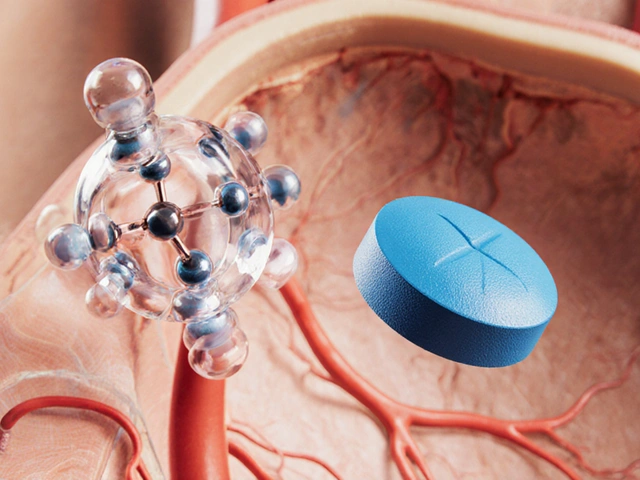When it comes to managing ADHD, many people feel a knot in their stomach at the thought of discussing medication options with a doctor. Atomoxetine is a non‑stimulant prescription often recommended when stimulants aren't a good fit. Knowing what to say, what to ask, and how to frame your concerns can turn a nervous visit into a productive partnership.
Why preparation matters
Going in without a plan can leave you walking out with unanswered questions or a prescription you’re unsure about. A clear agenda helps the Physician understand your goals, track your progress, and address safety issues before they become problems.
Know the basics about atomoxetine
Before you sit down, get comfortable with the core facts:
- Atomoxetine is a selective norepinephrine reuptake inhibitor (NRI) that increases norepinephrine levels in the brain, improving attention and reducing impulsivity.
- It’s approved by the Food and Drug Administration (FDA) for children, adolescents, and adults with ADHD.
- Typical starting dose for children 6‑12 years old is 0.5 mg/kg per day, usually taken in the morning. Adults often start at 40 mg once daily, with a possible increase to 80 mg after a few weeks.
- Common side effects include stomach upset, decreased appetite, dry mouth, and fatigue. Rare but serious risks are liver injury and suicidal thoughts, especially in younger patients.
- Unlike most stimulant ADHD meds, atomoxetine has a low abuse potential because it doesn’t produce a rapid “high.”
Having these points at your fingertips means you can ask focused questions instead of vague ones.
Gather your personal health info
Bring a concise snapshot of the factors that influence how atomoxetine will work for you:
- Current ADHD symptom checklist - date, severity, situations where it’s most disruptive.
- List of all medicines you’re taking, including over‑the‑counter drugs and supplements.
- Any history of liver disease, heart problems, or mood disorders.
- Recent lab results (especially liver function tests) if you’ve had them.
- Insurance details - formulary coverage, co‑pay estimates, prior‑authorization steps.
These data let the physician tailor the Prescription and flag potential interactions.
Structure the conversation
Think of the appointment as a two‑way dialogue. Here’s a simple flow you can follow:
- Opening: “I’ve been researching ADHD treatments and I’m interested in learning more about atomoxetine.”
- Share your story: Briefly describe how symptoms affect school, work, or relationships.
- Ask specific questions:
- “What dosage would you start me on, and how long before I might see benefits?”
- “How should I monitor side effects, especially the rare ones?”
- “Can atomoxetine be combined with other ADHD meds or therapy?”
- “What lab tests do you recommend before and during treatment?”
- Discuss logistics: insurance coverage, refill schedule, and when to schedule a follow‑up.
- Close with next steps: confirm the dose, the date for the next visit, and any homework (e.g., start a symptom diary).

Tips for a productive visit
- Write down all questions beforehand - it’s easy to forget them when you’re anxious.
- Use plain language; you don’t need medical jargon to be heard.
- If something isn’t clear, ask the doctor to repeat or rephrase it.
- Bring a trusted friend or family member if you think you’ll need support remembering details.
- Ask for written instructions or a hand‑out about atomoxetine.
Common pitfalls to avoid
- Leaving out past substance use - even occasional caffeine can affect how the medication works.
- Minimizing side effects because you think they’re “normal.” Early reporting helps the doctor adjust the dose.
- Assuming atomoxetine works instantly. It can take 4‑6 weeks for full effect.
- Skipping follow‑up appointments - ongoing monitoring is key for safety and efficacy.
Atomoxetine vs. stimulant medications
| Factor | Atomoxetine | Methylphenidate (Stimulant) |
|---|---|---|
| Mechanism | Selective norepinephrine reuptake inhibition | Dopamine‑norepinephrine reuptake inhibition |
| Onset of benefit | 2‑4 weeks (full effect 4‑6 weeks) | 30‑60 minutes |
| Duration of action | Once‑daily (12‑24 h) | Short‑acting: 3‑5 h; Long‑acting: 8‑12 h |
| Abuse potential | Low | High |
| Common side effects | Stomach upset, appetite loss, fatigue | Insomnia, increased heart rate, jitteriness |
| Typical dose range | 40‑100 mg/day (adult) | 5‑60 mg/day (depends on formulation) |
Choosing between them depends on your lifestyle, health history, and how you respond to each class. The comparison table can help you ask the right questions about why the doctor may favor one over the other.

Checklist before your appointment
- Symptom diary (past 2‑4 weeks)
- Current medication & supplement list
- Recent lab results (especially liver function)
- Insurance formulary info for atomoxetine
- Prepared list of at least five questions
- Notebook or phone for note‑taking
Frequently Asked Questions
Can I take atomoxetine if I have a history of depression?
Yes, but the doctor will monitor mood closely. Some patients experience increased anxiety or depressive symptoms, especially early in treatment, so regular check‑ins are essential.
How long should I wait before noticing improvement?
Most people report a subtle change after 2‑3 weeks, but the full therapeutic effect often appears around the 4‑6 week mark.
Do I need liver function tests while on atomoxetine?
Baseline liver enzymes are recommended before starting. If you have risk factors, the doctor may repeat tests every 3‑6 months.
Can atomoxetine be used with behavioral therapy?
Absolutely. Combining medication with CBT or coaching often yields better outcomes than either approach alone.
What should I do if I miss a dose?
Take it as soon as you remember, unless it’s less than 6 hours before the next scheduled dose. Then skip the missed one and continue with the regular schedule.
Is atomoxetine safe during pregnancy?
The drug is classified as pregnancy category C. Discuss risks and alternatives with your doctor before starting or continuing.
Will my insurance cover atomoxetine?
Most plans cover it, but you may need prior authorization. Bring your formulary list and ask the office staff to help with paperwork.
Can I stop atomoxetine abruptly?
It’s best to taper under medical supervision to avoid rebound ADHD symptoms or mood changes.
What are the most common reasons doctors switch from stimulants to atomoxetine?
Poor response to stimulants, intolerable side effects, high abuse risk, or co‑existing conditions like anxiety often prompt a switch.
Take the next step with confidence
Walking into a medical appointment armed with facts, a clear agenda, and a friendly mindset puts you in the driver’s seat of your ADHD treatment. Whether you end up starting atomoxetine or exploring another option, the conversation you have today will shape the support you receive tomorrow.







15 Comments
Walking into a doctor's office armed with a fact sheet feels like stepping onto a battlefield of bureaucracy. Atomoxetine, the non‑stimulant hero of the ADHD arsenal, demands respect and a clear game plan. First, declare your goals: “I need sharper focus at work without the jittery side‑effects of stimulants.” Bring a printed symptom diary that charts at least two weeks of concentration lapses and hyper‑active moments. List every prescription, supplement, and even that nightly herbal tea you sip because the doctor will hunt for hidden interactions. Mention any history of liver disease, cardiac issues, or mood disorders before they can be glossed over. Ask for baseline liver function labs and a timeline for retesting, because safety is non‑negotiable. Inquire about the starting dose, reminding the physician that adults typically begin at 40 mg and titrate upward only after a few weeks. Press for a realistic expectation: “When should I notice a measurable improvement?” Emphasize that you understand the full effect may take four to six weeks, not the instant buzz of stimulants. Request written instructions on monitoring side effects, especially appetite loss and fatigue, so you can act fast if they appear. Don’t shy away from discussing insurance – ask for formulary details, co‑pay estimates, and whether prior authorization is needed. Offer to schedule a follow‑up in six weeks, showing you’re committed to the partnership. If the doctor mentions combining atomoxetine with behavioral therapy, nod and ask for recommended providers. State unequivocally that you will not tolerate vague “watch and wait” plans without concrete milestones. Finally, leave the room with a printed prescription, a copy of the conversation notes, and the confidence that you’ve commanded the dialogue like a seasoned commander.
Oh, please! You think a checklist is the holy grail? I’d rather ask the doc why they even bother with atomoxetine when a good night’s sleep solves half the problem. And don’t even get me started on insurance hoops – they’re a circus, not a healthcare system.
One must approach the subject with a measured moral compass, for the physician‑patient covenant is sacrosanct. It is not merely a transactional exchange of scripts but a dialogue rooted in ethical responsibility. Presenting your data with humility, yet unwavering clarity, showcases respect for the clinician’s expertise. Nevertheless, do not allow the doctor’s authority to eclipse your own agency; you are the steward of your body. Remember, the virtue of informed consent lies in the balance of knowledge and trust.
Solid points overall. I’d add that keeping a simple log of daily energy levels can help differentiate whether fatigue is medication‑related or just a bad night’s sleep. Also, ask the doctor if they can set up a brief check‑in after the first month; it’s a good safety net.
hey doc, i bring all my meds list, even the herbal stuff i take at night, becasue i dont want any surprise. also my liver test from last month is attached, hope it helps u decide fast.
Got it! 👍 Make sure you ask for a printed handout – it’s way easier to keep track than a mental note. And don’t forget to bring that friend or family member, they can help you remember the dosage tweaks later. 😊
I appreciate the thoroughness of this guide. It’s comforting to know that bringing a symptom diary and lab results can make the conversation feel collaborative rather than intimidating. I’ll definitely use the suggested opening line to set a positive tone.
yeah, but you know they might hide the truth about side effects. governments don’t want you to know how these drugs affect the brain long term. keep your eyes open.
Here’s a quick cheat‑sheet: 1) Bring a 2‑week symptom log. 2) List ALL meds, even OTC. 3) Ask about baseline LFTs and monitoring schedule. 4) Clarify dose titration timeline – usually 4‑6 weeks to peak. 5) Confirm insurance steps for prior authorization. Following this list keeps the visit focused and ensures you leave with a clear plan.
Sure, but have you considered that the pharma industry is pulling the strings? They want you on stimulants so they can profit. Atomoxetine might be their way to diversify, but the real agenda is hidden.
Sounds solid.
Let’s get pumped! Take that checklist to the doc and own the conversation. You’ve got this – confidence is half the battle.
I see the value in being prepared, but I’d caution against sounding too aggressive. A calm, respectful tone usually yields better cooperation from the physician.
Wow, another “step‑by‑step” guide. Because the medical community clearly needs a PowerPoint from Reddit to tell them how to prescribe. Might as well email them a meme while you’re at it.
Hey, I get where you’re coming from, but this is actually super helpful for folks who feel anxious about the visit. Thanks for putting it all together in a clear way!
Write a comment